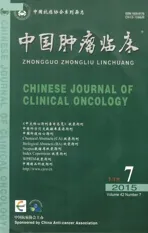HIFs维持肿瘤干细胞生物学特性及研究进展*
2015-11-23赵记华叶小群
赵记华 叶小群
·国家基金研究进展综述·
HIFs维持肿瘤干细胞生物学特性及研究进展*
赵记华 叶小群
缺氧微环境是实体肿瘤的典型特征,被认为是导致肿瘤进展及预后差的独立因素;作为肿瘤干细胞(cancer stem cells,CSCs)壁龛的关键组成部分,缺氧微环境对肿瘤干细胞在肿瘤中的演进以及抗凋亡能力起着重要的作用。缺氧诱导因子(hypoxia-inducible factors,HIFs)是肿瘤适应缺氧微环境的中心调节因子,能够诱导肿瘤干细胞生物学行为的改变如抗凋亡、增强耐药基因表达、促进肿瘤侵袭转移等,从而加速肿瘤恶性转变;同时HIFs也是维持肿瘤干细胞其干细胞特性的主要影响因素。本文对HIFs在维持肿瘤干细胞生物学特性的研究进展进行综述。
HIFs CSCs 抗凋亡 侵袭性 生物学特性
Department of Respiratory Medicine,the SecondAffiliated Hospital of Nanchang University,Nanchang 330006,China
This work was supported by the National Natural Science Foundation of China(Grant No:81160027)and the Natural Science
Foundation of Jiangxi Province(Grant No:20114BAB205001)
缺氧作为肿瘤常见的生理现象,被认为是临床上肿瘤进展、复发与转移的重要影响因素。恶性肿瘤在生长过程中,由于肿瘤细胞增生过快,造成局部组织严重缺氧以及供能与耗能之间的不平衡,形成一个与肿瘤生存相关的特殊微环境,称之为缺氧微环境。研究显示,缺氧在肿瘤相关间质微环境和肿瘤干细胞微环境的形成及演进中发挥重要作用[1]。随着干细胞的理论被引入肿瘤研究,肿瘤干细胞学说受到越来越多的关注,并在多种恶性肿瘤中都成功分离出肿瘤干细胞。根据CSC理论,肿瘤被认为是由一小部分不断增殖、能够自我更新和分化成异种肿瘤细胞的细胞发展而来。最近研究也为肿瘤干细胞的存在提供了确凿的证据,认为肿瘤干细胞是肿瘤侵袭、转移和复发等恶性演变的关键[2-3]。缺氧诱导因子(hypoxia-inducible factors,HIFs)家族作为调控缺氧应答的主要转录因子,对肿瘤发展、转移、侵袭和维持肿瘤干细胞的生物学特性起着重要的作用。
1 HIF与肿瘤组织缺氧的关系
人类许多实体瘤中都存在组织缺氧区域,而肿瘤细胞能够适应此缺氧环境,其最关键的转录因子是缺氧诱导因子[4]。HIFs是维持氧稳态的主要调节因子,介导生理性和病理性缺氧反应,作为一个异源二聚体,由氧调节的HIF-α亚基和持续表达的HIF-β
亚基组成。HIF-α又分为3个亚型:HIF-1α、HIF-2α和HIF-3α;HIF-1α和HIF-2α具有相似结构和作用,HIF-3α则通过与HIF-1α形成不活跃的二聚体,起到负调节的作用。HIF-1α与HIF-2α均含有N端和C端2个反式转录激活结构域(transactivation domain,TAD),TAD-N端介导异源二聚体的形成及其与DNA的结合,TAD-C端主要参与转录激活作用。常氧时,HIF-α的半衰期都非常短,其独特的氧依赖降解区中有两个特殊的脯氨酸残基能够被脯氨酸羟化酶(prolyl hydroxylase,PHD)识别并羟基化。羟基化的HIF-α与肿瘤抑制蛋白(von Hippel-Lindauprotein,pVHL)结合,pVHL复合体能够富集E3泛素连接酶,介导26S蛋白酶体对HIF-α的降解作用。在缺氧条件下,氧依赖降解区的PHD活性受抑制,稳定的HIF-α亚基与HIF-β亚基形成二聚体,由胞质穿到胞核,最后连接到缺氧反应元件(hypoxia responsive,HRE)上启动靶基因转录[5-6]。
HIFs家族主要通过调控各自独特的靶基因来启动一系列适应缺氧的转录反应来驱动肿瘤演进[4]。HIFs调控肿瘤糖酵解途径相关酶类,如乳酸脱氢酶A(LDHA)、丙酮酸脱氢酶1(PDK1)、葡萄糖转运蛋白(GLUT1)等基因的表达,使肿瘤细胞在缺氧条件下能够适应新的能量代谢方式,为肿瘤细胞提供能量[7]。肿瘤细胞中HIFs的活化还可以通过调节缺氧相关基因,如血管内皮生长因子(vascular endothelial growth factor,VEGF)、基质金属蛋白酶(matrix metalloproteinases,MMPs)、趋化因子受体4(chemokine receptor4,CXCR4)等的表达,这些基因主要通过编码抵抗凋亡和低氧损伤的蛋白,不仅促进肿瘤间质上皮转化、肿瘤细胞增殖,还可抑制细胞凋亡、诱导肿瘤的放化疗耐受性,从而维持肿瘤细胞生存,是肿瘤发生发展的重要因素[8-10]。
2 缺氧与肿瘤干细胞
越来越多的证据表明,肿瘤并不是由均一的细胞群体组成,许多肿瘤中也存在与正常干细胞类似的细胞等级分类。绝大部分的肿瘤细胞分裂增殖能力有限,但存在极少量的特殊肿瘤细胞与干细胞相似,具有高度增殖与自我更新能力,以及多向分化的潜能,这些细胞被称为肿瘤干细胞,被认为是肿瘤转移、复发的根源[2]。随后在许多人类的恶性肿瘤,包括肺、乳腺、脑、结肠、前列腺、胰腺等肿瘤中均发现类似细胞[11]。研究显示肿瘤干细胞的形成与其生存的肿瘤干细胞壁龛密切相关。肿瘤干细胞壁龛是干细胞居留的一个微环境,影响着干细胞的增殖和分化,通过与干细胞之间的直接或间接作用影响干细胞的命运[4]。而缺氧是肿瘤干细胞壁龛的关键组成部分,为肿瘤干细胞增殖的区域提供了一个异质性肿瘤微环境,是肿瘤干细胞形成和维持干细胞特性的主要微环境[12]。同时,缺氧微环境能够维持肿瘤细胞的未分化状态,增强其克隆形成率并能诱导特异性肿瘤干细胞标志基因CD133+的表达[13-14]。缺氧微环境对肿瘤细胞这种特异性影响,使得小部分异种肿瘤细胞CSC具有自我更新与不断增值的能力,最近研究表明,HIFs也是维持肿瘤干细胞生物学特性的重要因素[15-16]。
3 HIFs对肿瘤干细胞的影响
3.1HIFs促进肿瘤干细胞的侵袭性和转移
缺氧条件下HIF-α可以影响肿瘤血管和淋巴管生成以及上皮-间质转变(epithelial-mesenchymal transition,EMT),促进肿瘤细胞和CSC的侵袭和转移,从而引起对常规放化疗的抵抗,最终导致肿瘤的进展[1]。缺氧条件下HIF-1和HIF-2能够通过激活EMT相关通路(NF-κB、Notch、TGF-β、Wnt/β-catenin等)的调控子snail、twist以及相关的炎症因子(TNF-α、IL-6和IL-1β)诱导EMT的表型和特征,并能上调上皮钙黏蛋白(E-cadherin)、MMPs的表达从而促进肿瘤干细胞的侵袭和迁移[1,17]。同时在缺氧条件下肿瘤干细胞线粒体代谢产物能够抑制PHD活性,提高HIF-1稳定性,促进VEGF和促红细胞生成素的生成,增加肿瘤细胞血供,形成一个更适合肿瘤干细胞生存的微环境,使得细胞迁移和侵袭能力得到增强[5]。此外,HIF-α活化也可以诱导CXCR4和赖氨酸氧化酶(lysyl oxidase,LOX)在肿瘤细胞及正常祖细胞中的表达,CXCR4可介导干细胞顺着CXCR4配体CXCL12化学梯度归巢到肿瘤缺氧微环境,研究也证实了CXCR4在肿瘤细胞中的高表达与肿瘤转移性相关,LOX影响细胞外基质的结构,促进EMT增强肿瘤细胞的侵袭性[18]。
3.2HIFs增强肿瘤干细胞的抗凋亡能力
HIFs是肿瘤适应缺氧微环境的中心调节因子,也是影响肿瘤干细胞抗凋亡能力的主要因素。在缺氧刺激下,肿瘤干细胞的线粒体融合/分裂出现不平衡,线粒体融合蛋白Mfn1、Mfn2和BNIP3、BNIP3L等表达上调,两者在HIF-α诱导下使线粒体融合增加,形态由正常管状增大呈圆形或椭圆型;而线粒体融合增加,分裂受抑制,有助于维持线粒体膜电位,保护mtDNA,抑制肿瘤干细胞的凋亡[19]。Ye等[20]研究发现,人A549肺腺癌干细胞的线粒体膜电位明显高于普通肺癌细胞,干细胞的线粒体形态出现类似的融合扩大,避免了人肺腺癌干细胞在化疗药中的损伤凋亡。HIFs能够激活癌基因产物C-Raf、BC1-2,这些产物与线粒体外膜的电压依赖性阴离子通道
(voltage dependent anion channel,VDAC)蛋白结合,抑制VDAC诱导的线粒体膜去极化,干预功能性线粒体通透性膜孔(permeability transition pore,PTP)通道形成,阻断细胞色素C从线粒体释放,从而抑制肿瘤干细胞的调亡[21-22]。同时,HIFs诱导的线粒体形态及功能异常使ROS产生受到抑制,引起mtDNA突变从而刺激癌细胞转移相关蛋白的产生,促使肿瘤干细胞抗凋亡能力增强[23]。另外,HIF-α可以激活癌细胞NF-κB通路,NF-κB能够与它的靶基因的启动子区域相结合,有助于肿瘤细胞的存活而调控癌症发生[24]。HIF-α还能通过调控靶基因GLUT1、GLUT3、LDHA和PDK1等表达,使肿瘤干细胞适应新的细胞能量代谢方式,避免缺氧刺激细胞凋亡[25]。
3.3HIFs对肿瘤干细胞“干性”作用的调控
缺氧微环境中能够调控干细胞相关基因或信号通路促进肿瘤干细胞生成及表观遗传修饰,从而增强肿瘤的恶性潜能[4]。这可能是因为干细胞驻留在缺氧的壁龛里以减少氧化DNA的损伤,使肿瘤干细胞在缺氧壁龛中维持其干性[12]。缺氧条件下,HIF-1α能够与Notch结合,稳定和激活细胞内Notch的靶基因,维持CSC未分化状态;同时,HIF-1α能够竞争性与β-catenin结合,抑制β-catenin-TCF-4复合物的形成,激活Wint/β-catenin通路,进而在缺氧微环境中维持肿瘤干细胞的增殖与自我更新能力,促进肿瘤的发生[26-27]。此外,研究发现HIF-2α及人类胚胎干细胞基因(OCT-4、Sox2)在肿瘤干细胞中的表达显著高于非肿瘤干细胞[13-14]。Covello等[28]利用基因敲入技术将HIF-2α基因转入人胚胎干细胞后发现,HIF-2α与OCT-4的转录水平直接相关。HIF-2α主要通过Wnt/β-catenin通路,激活下游靶基因OCT-4、Sox2等,从而调节干细胞的功能[29]。研究也证实,HIF-2α优先表达在具有干细胞样特征的神经肿瘤细胞中,将干细胞调节因子OCT-4鉴定为HIF-2α的靶基因,使得HIF-2α与干细胞的生物学特性直接联系起来[30-31]。HIF-2α还能通过降低ROS水平,从而抑制p53基因,增强人类胚胎干细胞的干性和再生潜能[32]。另有研究发现,在肾透明癌中,HIF-2α能够增强另一个干细胞因子C-Myc的转录活力,与OCT-4共同调节干细胞的功能,促进肿瘤细胞的发展[33]。因此,CSCs可能通过HIFs依赖的分子机制部分调控肿瘤干细胞的增殖、抗凋亡及自我更新的能力。
综上所述,缺氧微环境下HIFs调控因子倾向于增强肿瘤干细胞的增殖、侵袭、迁移、血管形成和自我更新能力进而影响肿瘤微环境的发生和演进。因此,进一步了解HIFs对CSC分子机制的调节将有助于揭示肿瘤形成的机制,并为今后针对肿瘤干细胞靶向治疗提供新的治疗方法和策略,从而为降低肿瘤提复发、转移成为可能,提高肿瘤患者的生存率带来希望。
1Catalano V,Turdo A,Di Franco S,et al.Tumor and its microenvironment:A synergistic interplay[J].Seminars in Cancer Biology,2013,23(6):522-532.
2O'Connor ML,Xiang D,Shigdar S,et al.Cancer stem cells:A contentious hypothesis now moving forward[J].Cancer Lett,2014,344(2):180-187.
3Woll PS,Kjallquist U,Chowdhury O,et al.Myelodysplastic syndromes are propagated by rare and distinct human cancer stem cells in vivo[J].Cancer Cell,2014,25(6):794-808.
4Hanahan D,Weinberg RA.Hallmarks of Cancer:The Next Generation[J].Cell,2011,144(5):646-674.
5Philip B,Ito K,Moreno-Sanchez R,et al.HIF expression and the role of hypoxic microenvironments within primary tumours as protective sites driving cancer stem cell renewal and metastatic progression[J].Carcinogenesis,2013,34(8):1699-1707.
6Li SH,Chun YS,Lim JH,et al.von Hippel-Lindau protein adjusts oxygen sensing of the FIH asparaginyl hydroxylase[J].Int J Biochem Cell Biol,2011,43(5):795-804.
7Ferrer CM,Lynch TP,Sodi VL,et al.O-GlcNAcylation Regulates Cancer Metabolism and Survival Stress Signaling via Regulation of the HIF-1 Pathway[J].Mol Cell,2014,54(5):820-831.
8Mimeault M,Batra SK.Hypoxia-inducing factors as master regulators of stemness properties and altered metabolism of cancer-and metastasis-initiating cells[J].J Cell Mol Med,2013,17(1):30-54.
9Chaturvedi P,Gilkes DM,Takano N,et al.Hypoxia-inducible factor-dependent signaling between triple-negative breast cancer cells and mesenchymal stem cells promotes macrophage recruitment[J].Proc Nati Acad Sci U S A,2014,111(20):E2120-E2129.
10 Chaturvedi P,Gilkes DM,Wong CC,et al.Hypoxia-inducible factor-dependent breast cancer-mesenchymal stem cell bidirectional signaling promotes metastasis[J].J Clin Invest,2013,123(1):189-205.
11 Magee JA,Piskounova E,Morrison SJ.Cancer Stem Cells:Impact,Heterogeneity,and Uncertainty[J].Cancer Cell,2012,21(3):283-296.
12 Sugrue T,Lowndes NF,Ceredig R.Hypoxia Enhances the Radioresistance of Mouse Mesenchymal Stromal Cells[J].Stem Cells,2014,32(8):2188-2200.
13 Mathieu J,Zhang Z,Zhou W,et al.HIF Induces Human Embryonic Stem Cell Markers in Cancer Cells[J].Cancer Research,2011,71(13):4640-4652.
14 Kim RJ,Park JR,Roh KJ,et al.High aldehyde dehydrogenase activity enhances stem cell features in breast cancer cells by activating hypoxia-inducible factor-2α[J].Cancer Lett,2013,333(1):18-31.
15 Samanta D,Gilkes DM,Chaturvedi P,et al.Hypoxia-inducible factors are required for chemotherapy resistance of breast cancer stem cells[J].Proc Natl Acad Sci U S A,2014,111(50):E5429-E5438.
16 Keith B,Simon MC.Hypoxia-Inducible Factors,Stem Cells,and Cancer[J].Cell,2007,129(3):465-472.
17 Salnikov AV,Liu L,Platen M,et al.Hypoxia Induces EMT in Low and Highly Aggressive Pancreatic Tumor Cells but Only Cells with Cancer Stem Cell Characteristics Acquire Pronounced Migratory Potential[J].PLoS One,2012,7(9):e46391.
18 Jennbacken K,Welén K,Olsson A,et al.Inhibition of metastasis in a castration resistant prostate cancer model by the quinoline-3-carboxamide tasquinimod(ABR-215050)[J].The Prostate,2012,72(8):913-924.
19 Chiche J,Rouleau M,Gounon P,et al.Hypoxic enlarged mitochondria protect cancer cells from apoptotic stimuli[J].J Cell Physiol,2010,222(3):648-657.
20 Ye XQ,Li Q,Wang GH,et al.Mitochondrial and energy metabolism-related properties as novel indicators of lung cancer stem cells[J].Int J Cancer,2011,129(4):820-831.
21 Sharaf El Dein O,Gallerne C,Brenner C,et al.Increased expression of VDAC1 sensitizes carcinoma cells to apoptosis induced by DNA cross-linking agents[J].Biochemi Pharmacol,2012,83(9):1172-1182.
22 Brahimi-Horn MC,Ben-Hail D,Ilie M,et al.Expression of a Truncated Active Form of VDAC1 in Lung Cancer Associates with Hypoxic Cell Survival and Correlates with Progression to Chemotherapy Resistance[J].Cancer Res,2012,72(8):2140-2150.
23 Ralph SJ,Rodríguez-Enríquez S,Neuzil J,et al.The causes of cancer revisited:"Mitochondrial malignancy"and ROS-induced oncogenic transformation-Why mitochondria are targets for cancer therapy[J].Mol Aspects Med,2010,31(2):145-170.
24 Spirina LV,Kondakova IV,Choynzonov EL,et al.Expression of vascular endothelial growth factor and transcription factors HIF-1,NF-kB expression in squamous cell carcinoma of head and neck;association with proteasome and calpain activities[J].J Cancer Res Clin Oncol,2013,139(4):625-633.
25 Han S.Expression of pyruvate dehydrogenase kinase-1 in gastric cancer as a potential therapeutic target[J].Int J Oncol,2012,42(1):44-54.
26 Kaufman DS.HIF hits Wnt in the stem cell niche[J].Nat Cell Biol,2010,12(10):926-927.
27 Qiang L,Wu T,Zhang HW,et al.HIF-1alpha is critical for hypoxia-mediated maintenance of glioblastoma stem cells by activating Notch signaling pathway[J].Cell Death Differ,2012,19(2):284-294.
28 Covello KL,Kehler J,Yu H,et al.HIF-2alpha regulates Oct-4:effects of hypoxia on stem cell function,embryonic development,and tumor growth[J].Genes Dev,2006,20(5):557-570.
29 Kelly KF,Ng DY,Jayakumaran G,et al.β-Catenin Enhances Oct-4 Activity and Reinforces Pluripotency through a TCF-Independent Mechanism[J].Cell Stem Cell,2011,8(2):214-227.
30 Pietras A,Gisselsson D,øra I,et al.High levels of HIF-2α highlight an immature neural crest-like neuroblastoma cell cohort located in a perivascular niche[J].J Pathol,2008,214(4):482-488.
31 Bhaskara VK,Mohanam I,Rao JS,et al.Intermittent hypoxia regulates stem-like characteristics and differentiation of neuroblastoma cells[J].PLoS One,2012,7(2):e30905.
32 Das B,Bayat-Mokhtari R,Tsui M,et al.HIF-2α Suppresses p53 to Enhance the Stemness and Regenerative Potential of Human Embryonic Stem Cells[J].Stem Cells,2012,30(8):1685-1695.
33 Gordan JD,Bertout JA,Hu CJ,et al.HIF-2alpha promotes hypoxic cell proliferation by enhancing c-myc transcriptional activity[J]. Cancer Cell,2007,11(4):335-347.
(2015-02-03收稿)
(2015-03-11修回)
(编辑:杨红欣)
Research progress on effects of hypoxia inducible factors on maintenance of cancer stem cell biological characteristics
Jihua ZHAO,Xiaoqun YE
Xiaoqun YE;E-mail:511201663@qq.com
Hypoxic microenvironment is a typical characteristic of solid tumors and is considered an independent risk factor in tumor progression and poor prognosis.Hypoxic microenvironment is a critical part of cancer stem cell(CSC)niche and plays an important role in the evolution of cancer stem cells in tumors and in apoptosis resistance.As a key factor in the tumor's adaption to hypoxic microenvironment,hypoxia inducible factors(HIFs)can induce biological behavioral changes in CSCs that can accelerate tumor malignant transformation.Such behavioral changes include anti-apoptosis,enhancement of drug-resistance gene expression,and tumor invasion and metastasis.HIFs are also among the main factors affecting the capacity of CSCs to maintain their biological characteristics.In this review,the authors focus on recent advances in our understanding of the role that HIFs play in maintaining the biological characteristics of CSCs.
HIFs,CSCs,anti-apoptosis,invasion,biological characteristics

10.3969/j.issn.1000-8179.20150177
南昌大学第二附属医院呼吸内科(南昌市330006)
*本文课题受国家自然科学基金项目(编号:81160027)和江西省自然科学基金项目(编号:20114BAB205001)资助
叶小群511201663@qq.com
赵记华专业方向为肺癌干细胞相关性研究。
E-mail:286230479@qq.com
